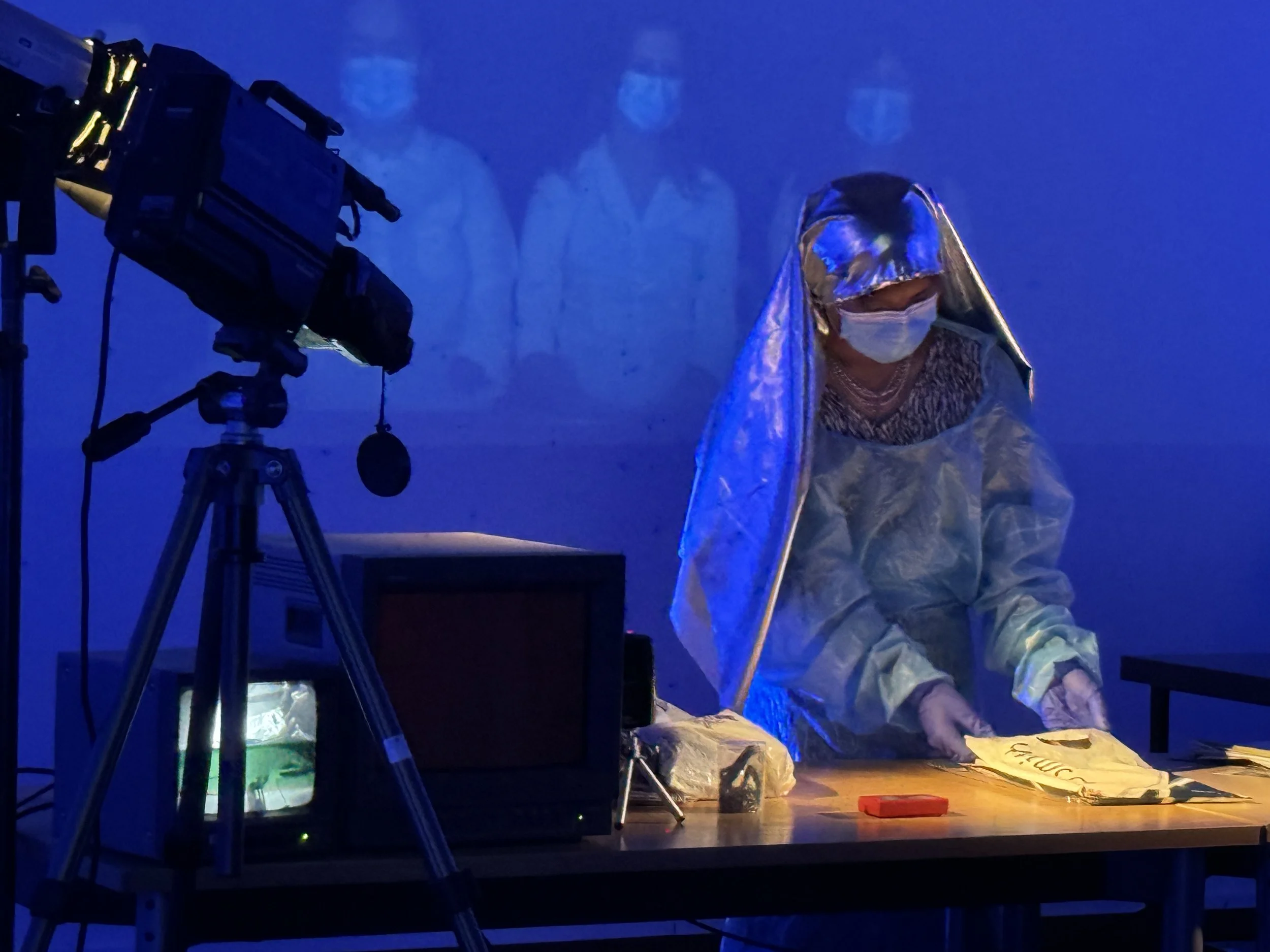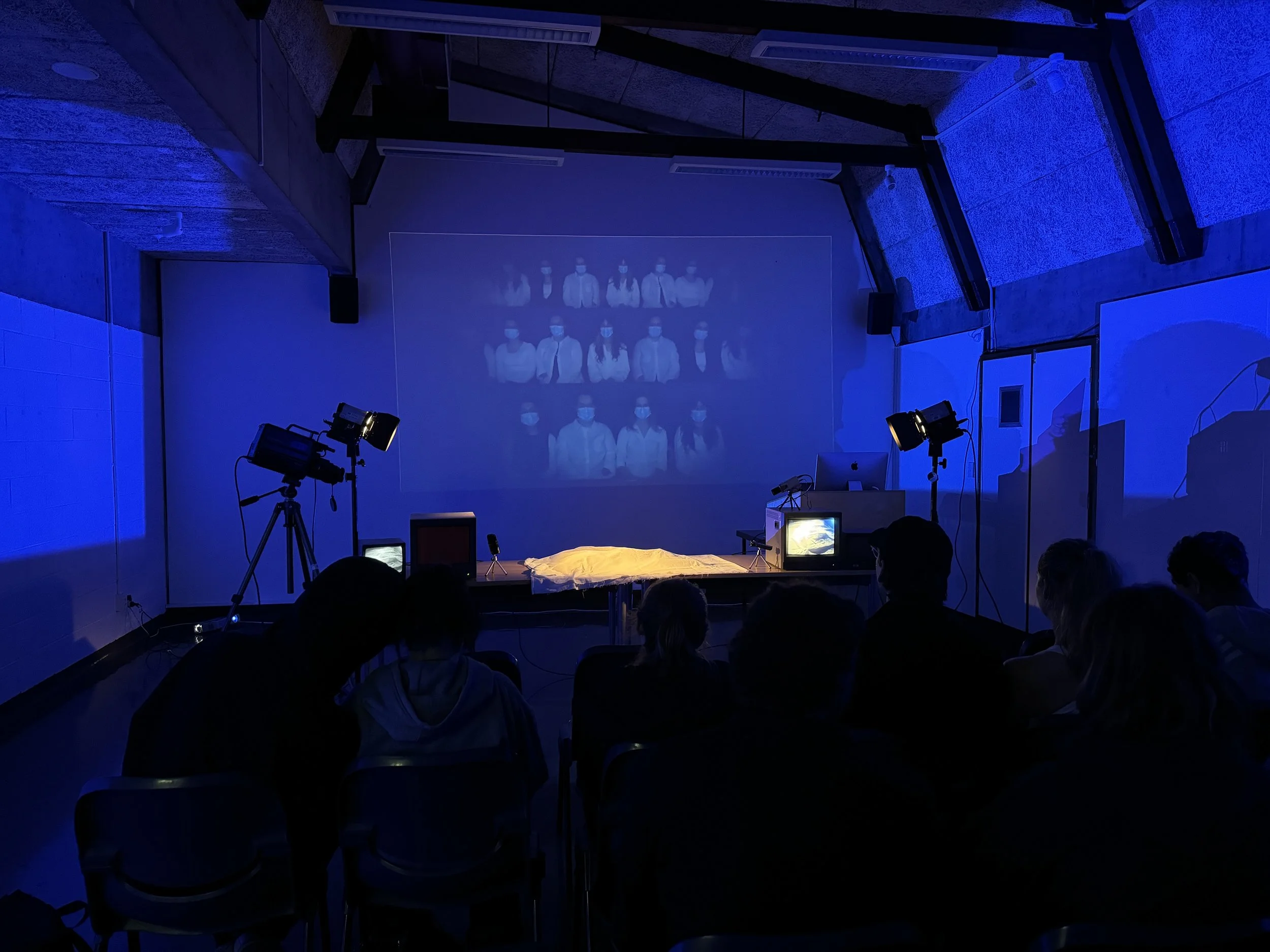Show & Tell
For CJ, May 2025
It is always apparent when you experience an especially palpable event in a stray room of an art university. The humdrum of the room itself is completely washed away, and you are transported exactly to where the artist wants you to go.
‘Show & Tell’ is an experimental performance piece by artist CJ, enacted for a supportive crowd of fellow students. I was there to witness what the venture into performance work would look like for the seasoned video artist.
Loosely framed in a two hour-ish flow of time, pertinent documents and objects were continuously revealed and gently set aside, paced by the artist’s semi-spontaneous narration of the layered family histories tied to the collection’s ‘recently deceased’ owner.
We listened to this figure before us in earnest– our beloved host, our somber surgeon, our merciless operator, who is dressed in doctor-esque scrubs over a zebra print dress, a surgical mask, some too-blue medical gloves, a pair of mini-heels, and the unmissable silver sheen of a nun-like headpiece.
Such a character could only declare their entrance by two dramatic piano notes, followed by the unmistakable click-clack of heels against the hard-jelled floor, making their way to the operating table ahead. This particular table was intensely monitored, with multiple cameras transfixed on a cloaked pile awaiting a live transmission of the anticipated handling through small tv screens.
The artefacts hidden underneath the white cloth were spotlit with a surprisingly warm hue amidst the immersive projections of an artificial blue that engulfed the room. Rows of pre-recorded individuals in matching surgical masks shuffled amongst themselves behind this ominous set-up, as if they, too, were observing every movement transpiring in the room. The event was about to begin, and we held our breaths for it.
The artist leaned casually against the table and lifted the protective cloth as they made their first announcement:
“We have here.. a collection of items, all fresh, straight from the morgue, recently deceased,” Then, on cue, the spit-sputtering of a smoke machine started to slowly weave itself into the already surreal air, almost in sync with the flickering of the tv screens, the type that are considered outmoded now. The live surveillance was a meticulous system and collective execution reminiscent of Nam June Paik’s installation ‘Three Eggs’(1975-1982).
“We’ll begin this show and tell… of this individual that… has a very peculiar, interesting story, dating from the 2000s to the present; a very interesting story, one that might interest you. The story sort of begins in the late nineties..” They continued, with their curious use of pauses and periodically vague mannerisms, to reveal even more materials for us to feast on. As one became increasingly transfixed upon the intricacies of every word in this possibly pseudo-fictional life story, the realisation emerged: the ‘deceased’ person they were speaking about was surely themselves.
Nevertheless, the impermanence of those uttered words that were floating alongside the echoing audio track and neon-fog only added to the absurdity of the performance, thereby prompting the questioning of whether or not this was the work of an unreliable narrator– yet the documents felt distinctly real: we saw newspaper clippings, passport documents, and citizenship applications sliding out of Officemax Redsleeves and white envelopes. This was visual language that supposedly guaranteed their status as official evidence.
From being born in the Phillipines to migrating over to Aotearoa at a very young age, the artist continued to describe the journey across the island to Ōtautahi for university. The feeling of still not fitting in even after the arduous progression from being an outsider to becoming a citizen in this country permeated their existential dialogue. This overarching yearning to belong was very much alive– a stream of wistful consciousness stretched out into the malleable amount of time we were spending so intimately together. It was as if this character was actively attempting to give this archive the respect and ceremony it deserves, whilst learning in real time how to take up space in a foreign room.
The boundaries between the character’s story and the artist’s identity were blurred, as intended, and as it should be. They revealed a cassette tape, that they guessed was “made sometime during .. 2010.. 2012..2013..?” then mentioned its ties to a karaoke machine. Ghostly renditions of an iconic song started to echo, “Caaan youuu feeeeel theee loooove tooniiiight…” The narration continued as the audio took on an eerie life of its own, dragging in every day sounds such as the whistling of pots and the buzzing of cicadas, crisp in contrast.
This bizarre self-autopsy served an emotional investigation through the formal handling of a family archive, no doubt proving a meaningful experiment in the artist’s own practice and their confrontation of belonging. It was a fascinating event of witnessing an artist step into a character to find belonging– not in place, but in the peculiar medium of the investigative performance. Perhaps one can find this permanence in art-making, in speaking permeable words into the air, and in laying bare your childhood photographs for all to examine.
The story continued up until a few weeks before the present moment, the point at which this individual had been declared ‘deceased’. The question is, what of the individual after this point? How would they be archived, dissected, respected, discussed, and remembered in the future? And would it look like a wonderfully absurd performance over an operating table?
Show & Tell
University of Canterbury
13 May 2025




